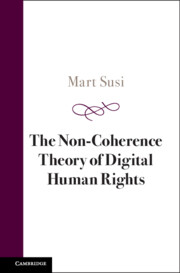Book contents
- The Non-coherence Theory of Digital Human Rights
- The Non-coherence Theory of Digital Human Rights
- Copyright page
- Contents
- Acknowledgements
- Introduction
- Part I The Contextual Challenges and Purpose of the Non-coherence Theory of Digital Human Rights
- Part II Reflections on Some Theories and Doctrines
- Part III The Core Elements of Non-coherence Theory
- 13 Doctrinal Changes in Scope and the Meaning of Human Rights
- 14 The Variance Principle and Digital Transparency
- 15 Legal Certainty and Uncertainty
- 16 On Foreseeability and Non-foreseeability
- 17 Reflections from the Academic Debate
- Part IV The Impact of the Non-coherence Theory
- Part V Internet Balancing Formula
- In Lieu of the Concluding Remarks
- Index
15 - Legal Certainty and Uncertainty
from Part III - The Core Elements of Non-coherence Theory
Published online by Cambridge University Press: 22 February 2024
- The Non-coherence Theory of Digital Human Rights
- The Non-coherence Theory of Digital Human Rights
- Copyright page
- Contents
- Acknowledgements
- Introduction
- Part I The Contextual Challenges and Purpose of the Non-coherence Theory of Digital Human Rights
- Part II Reflections on Some Theories and Doctrines
- Part III The Core Elements of Non-coherence Theory
- 13 Doctrinal Changes in Scope and the Meaning of Human Rights
- 14 The Variance Principle and Digital Transparency
- 15 Legal Certainty and Uncertainty
- 16 On Foreseeability and Non-foreseeability
- 17 Reflections from the Academic Debate
- Part IV The Impact of the Non-coherence Theory
- Part V Internet Balancing Formula
- In Lieu of the Concluding Remarks
- Index
Summary
Non-coherence theory says that in order to speak of legal certainty in the digital domain, a domain-specific concept of justice has to be developed. But this would already lead to a far-reaching conclusion that there can exist different ideas of justice, which is a phenomenon of relativity reaching to the deepest bottom of human rights systems. A commonality would therefore need to be found between the concepts of legal certainty and predictability. Such commonality can be found from the functions of legal certainty and predictability, where the outcome of a judicial or quasi-judicial assessment assumes the existence of standards which are constant. Pursuing this commonality leads to the term the thesis of immunity to time. We observe a specific phenomenon of non-coherence, which is a simplification and move towards thinness because predictability can, by and large, be considered legal certainty without qualitative elements, such as the ideas of justice or equality.
Keywords
- Type
- Chapter
- Information
- The Non-Coherence Theory of Digital Human Rights , pp. 179 - 195Publisher: Cambridge University PressPrint publication year: 2024

